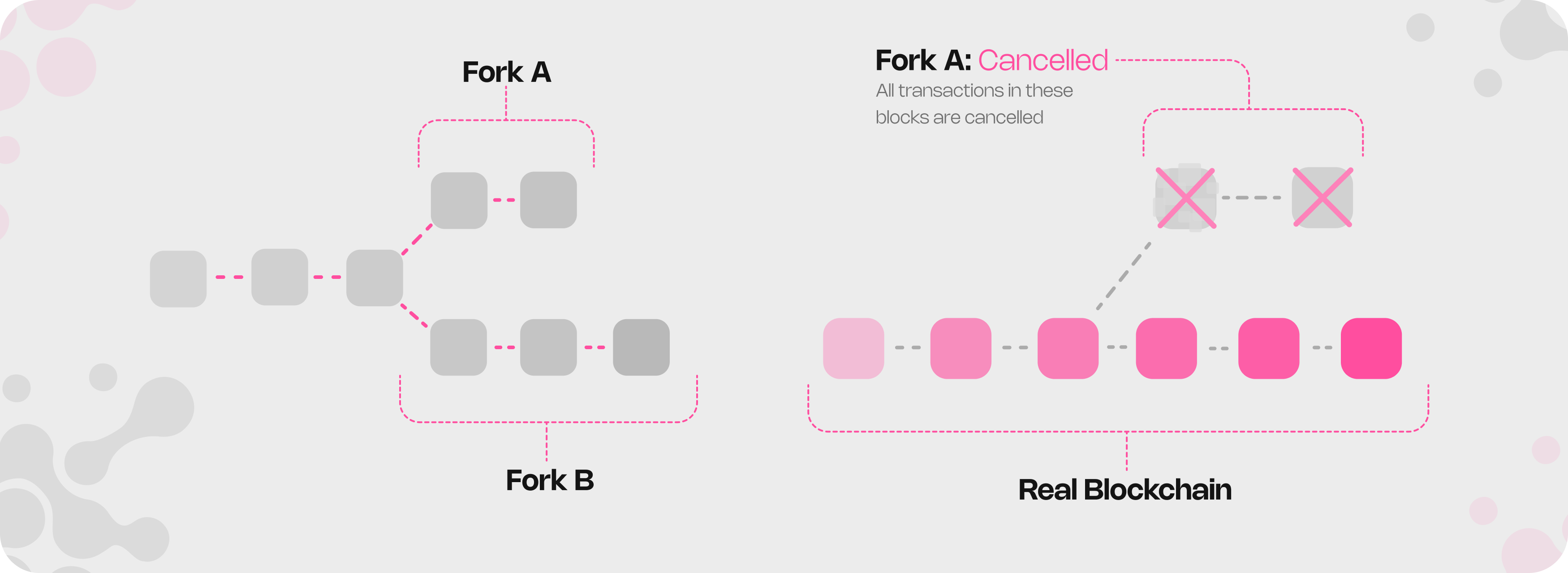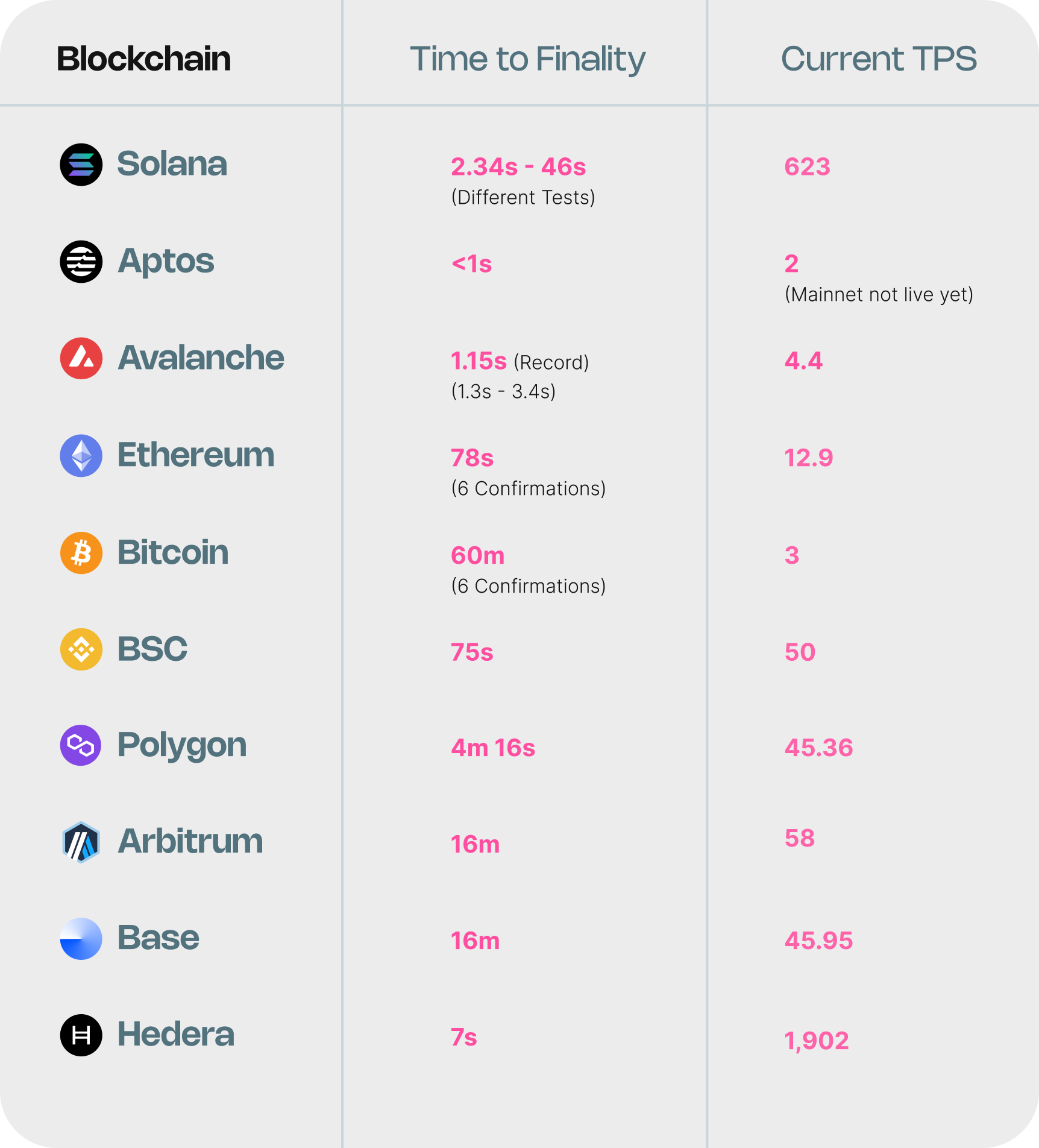Understanding Finality in Web3 and How to Improve It
Finality is a critical concept in blockchain technology that refers to the point at which a transaction is considered permanent and immutable

Finality is a critical concept in blockchain technology that refers to the point at which a transaction is considered permanent and immutable. While many in the Web3 community focus on TPS (transactions per second) to measure a blockchain’s performance, this is only half the story. The real measure of a blockchain's efficiency and reliability is a combination of TPS and TTF (time to finality).
In blockchain, blocks are added to the chain, but these additions are temporary. Due to the decentralized nature of blockchain networks, multiple versions of the chain (forks) can exist temporarily until the network agrees on a single chain. This is because multiple blocks can be added at any given point. This is forking, and this process introduces ambiguity, as any block and its transactions can be reversed if the network chooses a different chain. Hence it is recommended to wait for a certain number of blocks to be added to consider that the transaction is successful.

For instance, in Bitcoin, it is generally advised to wait until a transaction is six blocks deep. This means five additional blocks have been built on top of your transaction block, making it statistically unlikely to be reversed from this point. Usually, we don’t face any issue with such probabilistic finality, but this becomes an important factor while performing high-value or multiple transactions where reversals are unacceptable.
Time to Finality (TTF) ensures network reliability, prevents double-spending, and builds user trust. For smart contracts, finality guarantees that the results are fixed and immutable once executed. This certainty is crucial for complex financial transactions, cross-chain operations, and any scenario where the irreversibility of actions is paramount. Understanding finality is critical to grasping the actual efficiency and security of a blockchain network.
Types of Finality
Understanding the different types of finality helps you understand how different blockchains ensure transaction permanence. Here are some types of finality

- Probabilistic Finality: In probabilistic finality, a transaction becomes increasingly secure and less likely to be reversed as more blocks are added to the blockchain. This type is common in Proof of Work (PoW) systems. For instance, in Bitcoin (BTC), a transaction is considered more secure with each additional block, typically reaching a high level of confidence after six blocks. However, until a certain number of blocks are confirmed, there’s a chance that the transaction could be reversed due to chain reorganization.
- Economic Finality: Economic finality is used in Proof of Stake (PoS) systems, where finality is determined by economic penalties for validators who act dishonestly. Ethereum (ETH) employs this type of finality. Validators stake their tokens as collateral, and if they try to reverse a transaction, they risk losing their staked assets. This economic disincentive helps ensure that once a transaction is validated, it remains final.
- Absolute Finality: Absolute finality ensures that once a transaction is included in a block, it is immediately final and cannot be reverted. Finality is reached by a unique consensus mechanism, such as Costmos BFT tender mint, where the transactions are added by trusted validators.
- Instant Finality: Instant finality refers to transactions that are final immediately upon inclusion in the blockchain, without the need for additional confirmations. Sharedeum is an example of a blockchain that is moving towards providing instant finality. This offers users the highest level of transaction certainty.
How to scale and improve Finality
Improving Finality has been a constant discussion and point of research for many years. It is crucial for applications and participants that require rapid and trustworthy transaction validation, such as financial services and smart contracts. Here are some high-level pointers discussing a few ways in which we can improve Finality
- Improving the Consensus Mechanism
- Adopting Proof of Stake (PoS): Transition from Proof of Work (PoW) to PoS. This involves replacing the energy-intensive PoW consensus with PoS, where validators are chosen based on the number of tokens they hold and are willing to “stake” as collateral. PoS systems generally achieve consensus faster and with lower energy consumption. In PoS, validators are penalized (slashed) if they act dishonestly or fail to validate correctly. This economic disincentive encourages honest behavior, leading to quicker and more reliable finality.
- Integrating Byzantine Fault Tolerance (BFT): BFT algorithms allow the network to reach consensus even if some nodes are faulty or malicious. This ensures that the network can confirm transactions quickly and securely. Tendermint, for example, is a BFT consensus algorithm used in Cosmos, which ensures immediate finality once a transaction is included in a block.
- Hybrid Consensus Models: Combine PoS with BFT: Implementing a hybrid consensus mechanism that leverages both PoS and BFT. This can balance the strengths of both systems. For example, Algorand uses a pure PoS model combined with Byzantine Agreement to ensure quick finality, making transactions irreversible once they are included in a block.
- Adopting Proof of Stake (PoS): Transition from Proof of Work (PoW) to PoS. This involves replacing the energy-intensive PoW consensus with PoS, where validators are chosen based on the number of tokens they hold and are willing to “stake” as collateral. PoS systems generally achieve consensus faster and with lower energy consumption. In PoS, validators are penalized (slashed) if they act dishonestly or fail to validate correctly. This economic disincentive encourages honest behavior, leading to quicker and more reliable finality.
- Utilizing Layer 2 Solutions
- Implementing Rollups: Deploy Optimistic Rollups: These rollups aggregate multiple transactions off-chain and submit them to the main chain in batches. They assume transactions are valid by default but have mechanisms to challenge fraudulent transactions. This reduces the load on the main chain and speeds up finality.Use ZK Rollups: Zero-Knowledge Rollups validate transactions off-chain using cryptographic proofs. When these batches are submitted to the main chain, they come with proofs that guarantee the transactions are valid. This ensures immediate finality upon submission, significantly speeding up the process.
- Adopting Sidechains: Set up independent blockchains: Sidechains operate parallel to the main chain and handle their own transactions and consensus. Transactions processed on a sidechain can be confirmed more quickly due to optimized consensus mechanisms specific to the sidechain. The sidechain periodically submits a summary of its state to the main chain, ensuring that even though transactions are processed off-chain, they still benefit from the main chain’s security. This anchoring ensures finality and prevents double-spending across chains.
- Using State Channels: State channels allow two parties to conduct multiple transactions off-chain, with only the final state being recorded on the main chain. This drastically reduces the number of on-chain transactions and speeds up the finality of each transaction within the channel.
- Implementing Rollups: Deploy Optimistic Rollups: These rollups aggregate multiple transactions off-chain and submit them to the main chain in batches. They assume transactions are valid by default but have mechanisms to challenge fraudulent transactions. This reduces the load on the main chain and speeds up finality.Use ZK Rollups: Zero-Knowledge Rollups validate transactions off-chain using cryptographic proofs. When these batches are submitted to the main chain, they come with proofs that guarantee the transactions are valid. This ensures immediate finality upon submission, significantly speeding up the process.
- Improving Network Efficiency
- Optimizing Nodes: Ensuring that nodes are well-synced and highly connected reduces the time it takes for transactions to propagate through the network. This can be achieved through network upgrades, improved hardware, and optimized software.
- Reducing Block Time: Reducing the time between block creations means transactions are included in blocks more frequently. This can be done by optimizing the consensus protocol and ensuring that blocks are propagated quickly across the network.
- Enhancing Data Availability: Implementing schemes that ensure all nodes have quick access to the necessary data for transaction validation improves the speed of reaching consensus. This can involve advanced data distribution techniques and protocols.Data sharding: Dividing the blockchain into shards, each responsible for a subset of the data, ensures that data storage and access are distributed evenly across the network. This enhances the efficiency of data retrieval and validation, speeding up finality.
- Optimizing Nodes: Ensuring that nodes are well-synced and highly connected reduces the time it takes for transactions to propagate through the network. This can be achieved through network upgrades, improved hardware, and optimized software.
- Implementing New Cryptographic Techniques
- Zero-Knowledge Proofs (ZKPs): Zero-Knowledge Proofs allow transactions to be validated without revealing the underlying data. This ensures that transactions can be confirmed quickly and securely without compromising privacy. Implement zk-SNARKs or zk-STARKs: These specific types of ZKPs provide scalable and efficient transaction validation, ensuring that finality is achieved promptly.
- Zero-Knowledge Proofs (ZKPs): Zero-Knowledge Proofs allow transactions to be validated without revealing the underlying data. This ensures that transactions can be confirmed quickly and securely without compromising privacy. Implement zk-SNARKs or zk-STARKs: These specific types of ZKPs provide scalable and efficient transaction validation, ensuring that finality is achieved promptly.
- Aggregated Signatures: Combine digital signatures: Aggregating multiple digital signatures into a single signature reduces the amount of data that needs to be processed and validated. This speeds up the confirmation process.
- Sharding: Sharding splits the blockchain into smaller parts (shards) that can process transactions in parallel. Each shard operates like a mini blockchain, handling its own transactions and consensus.Cross-shard communication: Developing efficient cross-shard communication protocols ensures that transactions across different shards can be validated and finalized quickly, improving overall network efficiency and finality.
By implementing these specific actions within each category, blockchain networks can enhance their finality, ensuring that transactions are confirmed more quickly and securely, thus improving overall network performance.
Finality remains a critical factor in blockchain development. As the technology evolves, we can expect advancements in consensus mechanisms, layer 2 solutions, and cryptographic techniques to improve finality times. These improvements will likely enable new use cases, particularly in sectors requiring rapid and irreversible transactions.
The focus is shifting from raw transaction speed to a balance of speed, security, and finality. This shift will drive innovation in scaling solutions and cross-chain interoperability. As blockchain adoption grows, finality will play a key role in shaping user trust and enterprise integration.
Developers and blockchain architects must consider finality alongside other performance metrics when designing and implementing blockchain systems. The future of blockchain technology will likely see a convergence of high throughput and near-instant finality, opening doors to more efficient and reliable decentralized applications.
About Arcana Network
Arcana Network is building a modular L1 to power Chain Abstraction and intents, helping developers significantly improve user experience in Web3. Since 2021, we've introduced three groundbreaking products.
First up is Auth SDK, a decentralized social login to generate non-custodial Wallets. It is the fastest social login in Web3, with a sub-3-second login time, and is free of cost. Games and consumer apps widely use the auth SDK to simplify Web3 user onboarding. Instantly, you can get a secure, in-app wallet with no passwords or installations needed.
Next, Arcana Gasless is based on ERC-4337 Account Abstraction and enables developers to sponsor gas fees for users.
Our third product, SendIt, is a consumer app that redefines crypto payments by allowing users to send crypto to an email address, making transactions effortless and inclusive. SendIt has partnered with BNB and OKX.
Arcana has raised $4.5M from 40+ leading investors, including Balaji S, Founders of Polygon, John Lilic, Santiago Roel, and funds like Woodstock, Republic, Fenbushi, Polygon ventures, DCG, and others.
Official Links: Website | Telegram | Twitter | GitHub | Discord
References
- Block Time vs Finality
- Finality in Blockchain
- What Is Block Finality?
- Blockchain Finality- Proof of Work and Proof of Stake
- Finality in Blockchain Consensus
- Instant vs Delayed Finality and its effect on user trust
- Understanding Chain Finality in Blockchain Technology
- Blockchain Finality
- What is finality in blockchain, and why does it matter?
- Finality in Bitcoin

